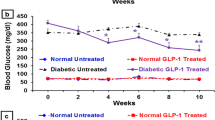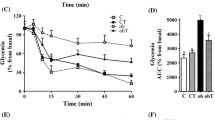Abstract
The expression and activities of constitutive nitric oxide synthase (cNOS) and inducible nitric oxide synthase (iNOS) in relation to insulin and glucagon secretory mechanisms were investigated in islets isolated from rats subjected to total parenteral nutrition (TPN) for 10 d. TPN is known to result in significantly increased levels of plasma lipids during the infusion time. In comparison with islets from freely fed control rats, islets taken from TPN rats at d 10 displayed a marked decrease in glucose-stimulated insulin release (4.65±0.45 ng/[islet·h] vs 10.25±0.65 for controls) (p<0.001) accompanied by a strong iNOS activity (18.3±1.1 pmol of NO/[min·mg of protein]) and a modestly reduced cNOS activity (11.3±3.2 pmol of NO/[min.mg of protein] vs 17.7±1.7 for controls) (p<0.01). Similarly, Western blots showed the expression of iNOS protein as well as a significant reduction in cNOS protein in islets from TPN-treated rats. The enhanced NO production, which is known to inhibit glucose-stimulated insulin release, was manifested as a strong increase in the cyclic guanosine 5′-monophosphate content in the islets of TPN-treated rats (1586±40 amol/islet vs 695±64 [p<0.001] for controls). Moreover, the content of cyclic adenosine monophosphate (cAMP) was greatly increased in the TPN islets (80.4±2.1 fmol/islet vs 42.6±2.6 [p<0.001] for controls). The decrease in glucose-stimulated insulin release was associated with an increase in the activity of the secretory pathway regulated by the cAMP system in the islets of TPN-treated rats, since the release of insulin stimulated by the phosphodiesterase inhibitor isobutylmethylxanthine was greatly increased both in vivo after iv injection and after in vitro incubation of isolated islets. By contrast, the release of glucagon was clearly reduced in islets taken from TPN-treated rats (33.5±1.5 pg/[islet·h] vs 45.5±2.2 for controls) (p<0.01) when islets were incubated at low glucose (1.0 mmol/L). The data show that long-term TPN treatment in rats brings about impairment of glucose-stimulated insulin release, that might be explained by iNOS expression and a marked iNOS-derived NO production in the β-cells. The release of glucagon, on the other hand, is probably decreased by a direct “nutrient effect” of the enhanced plasma lipids. The results also suggest that the islets of TPN-treated rats have developed compensatory insulin secretory mechanisms by increasing the activity of their β-cell cAMP system.
Similar content being viewed by others
References
Moncada, S., Palmer, R. M. J., and Higgs, E. A. (1991). Pharmacol. Rev. 43, 109–142.
Knowles, R. G. and Moncada, S. (1994). Biochem. J. 298, 249–258.
Panagiotidis, G., Alm, P., and Lundquist, I. (1992). Eur. J. Pharmacol. 229, 277–278.
Schmidt, H. H. H. W., Warner, T. D., Ishii, K., Sheng, H., and Murad, F. (1992). Science 255, 721–723.
Corbett, J. A., Wang, J. L., Misko, T. P., Zhao, W., Hickey, W. F., and McDaniel, M. L. (1993). Autoimmunity 15, 145–153.
Panagiotidis, G., Åkesson, B., Alm, P., and Lundquist, I. (1994). Endocrine 2, 787–792.
Alm, P., Ekström, P., Henningsson, R., and Lundquist, I. (1999). Diabetologia 42, 978–986.
Panagiotidis, G., Åkesson, B., Rydell, E., and Lundquist, I. (1995). Br. J. Pharmacol. 114, 289–296.
Gross, R., Roye, M., Manteghetti, M., Hillaire-Buys, D., and Ribes, G. (1995). Br. J. Pharmacol. 116, 1965–1972.
Salehi, A., Carlberg, M., Henningson, R., and Lundquist, I. (1996). Am. J. Physiol. 270, C1634-C1641.
Åkesson, B., Mosén, H., Panagiotidis, G., and Lundquist, I. (1996). Br. J. Pharmacol. 119, 758–764.
Salehi, A., Parandeh, F., and Lundquist, I. (1998). Cell Signal. 10, 645–651.
Tsuura, Y., Ishida, H., Shinomura, T., Nishimura, M., and Seino, Y. (1998). Biochem. Biophys. Res. Commun. 252, 34–38.
Henningsson, R. and Lundquist, I. (1998). Am. J. Physiol. 275, E500-E506.
Åkesson, B., Henningsson, R., Salehi, A., and Lundquist, I. (1999). J. Endocrinol. 163, 39–48.
Åkesson, B. and Lundquist, I. (1999). J. Physiol. 515, 463–473.
Henningsson, R., Alm, P., Ekström, P., and Lundquist, I. (1999). Diabetes 48, 66–76.
Henningsson, R., Alm, P., Lindström, E., and Lundquist, I. (2000). Am. J. Physiol. 279, E95-E107.
Corbett, J. A. and McDaniel, M. L. (1992). Diabetes 41, 897–903.
Eizirik, D. L. and Pavlovic, D. (1997). Diabetes/Metab. Rev. 13, 293–307.
Mandrup-Poulsen, T. (1996). Diabetologia 39, 1005–1029.
Unger, R. H. (1995). Diabetes 44, 863–870.
Sako, Y. and Grill, V. E. (1990). Endocrinology 127, 1580–1589.
Fan, B.-G., Salehi, A., Axelson, J., Sternby, B., Lundquist, I., Andrén-Sandberg, Å., and Ekelund, M. (1997). Pancreas 15, 147–153.
Vigili de Kreutzenberg, S., Lisato, G., Riccio, A., Giunta, F., Bonato, R., Petolillo, M., Tiengo, A., and Del Prato, S. (1988). Metabolism 37, 510–513.
Roth, B., Ekelund, M., Fan, B.-G., Hägerstrand, I., Salehi, A., Lundquist, I., and Nilsson-Ehle P. (1998). Intensive Care Med. 24, 716–724.
Shimabukuro, M., Ohneda, M., Lee, Y., and Unger, R. H. (1997). J. Clin. Invest. 100, 290–295.
Stamler, J. S., Simon, D. I., Osborne, J. A., Mullins, M. E., Jaraki, O., Michel, T., Singel, D. J., and Loscalzo, J. (1992). Proc. Natl. Acad. Sci. USA 89, 444–448.
Exton, J. H., Robinson, G. A., Sutherland, E. W., and Park, C. R. (1971). J. Biol. Chem. 246, 6166–6177.
Bihler, J., Sarvh, P. C., and Sloan, J. G. (1978). Biochim. Biophys. Acta 510, 349–360.
Trovati, M. and Anfossi, G. (1998). Diabetologia 41, 609–622.
Lernmark, Å. (1974). Horm. Res. 5, 227–233.
Jones, P. M., Persaud, S. J., Bjaaland, T., Pearson, J. D., and Howell, S. L. (1992). Diabetologia 35, 1020–1027.
Hellman, B., Idahl, L.-Å., Lernmark, Å., Sehlin, J., and Täljedal, I.-B. (1974). Excerpt. Med. Int. Congr. Ser. 312, 65–78.
Ammon, H. P. T. and Mark, M. (1985). Cell Biochem. Funct. 3, 157–171.
Åkesson, B. and Lundquist, I. (1999). Endocrine 11, 99–107.
Salehi, A., Parandeh, F., and Lundquist, I. (1998). Biosci. Rep. 18, 19–28.
Åkesson, B. and Lundquist, I. (1998). Biosci. Rep. 18, 199–213.
Salehi, A., Fan, B.-G., Ekelund, M., Nordin, G., and Lundquist, I. (2001). Am. J. Physiol. (Endocrinol. Metab.) 281, E171-E179.
Gotoh, M., Maki, T., Kiyoizumi, T., Satomi, S., and Monaco, A. P. (1985). Transplantation 40, 437,438.
Heding, L. (1966). In: Labelled proteins in tracer studies. Donato, L., Milhaud, G., and Sirchis, J. (eds.). Euratom: Brussels.
Ahrén, B. and Lundquist, I. (1982). Diabetologia 22, 258–263.
Panagiotidis, G., Salehi, A., Westermark, P., and Lundquist, I. (1992). Diabetes Res. Clin. Pract. 18, 167–171.
Bradford, M. M. A. (1978). Anal. Biochem. 84, 309–312.
Bruss, M. and Black, A. L. (1978). Anal. Biochem. 84, 309–312.
Author information
Authors and Affiliations
Corresponding author
Rights and permissions
About this article
Cite this article
Salehi, A., Ekelund, M., Henningsson, R. et al. Total parenteral nutrition modulates hormone release by stimulating expression and activity of inducible nitric oxide synthase in rat pancreatic islets. Endocr 16, 97–104 (2001). https://doi.org/10.1385/ENDO:16:2:097
Received:
Revised:
Accepted:
Issue Date:
DOI: https://doi.org/10.1385/ENDO:16:2:097




